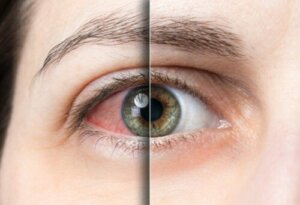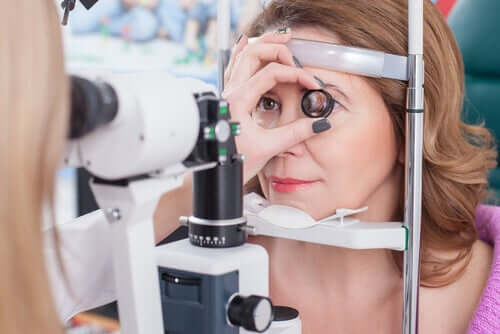Everything You Need to Know About a Detached Retina


Reviewed and approved by the doctor José Gerardo Rosciano Paganelli
A detached retina is a serious condition that should be treated as soon as possible to avoid possible irreversible vision problems. The retina is the inner layer of the back of the eye. The light that filters through the cornea passes through the lens to the retina. The retina senses the light and sends the images to the brain through the optic nerve.
If this situation occurs, it’s important to see an ophthalmologist immediately to have it checked out. The doctor will examine the retina and the rest of the internal structures of the eye. This way the doctor can diagnose the condition, and recommend any possible treatment.
Causes of a detached retina
A detached retina occurs when the external layer of the retina detaches from the back part of the retina. On the other hand, the vitreous body is a transparent gel that’s attached to the retina. With time, this internal liquid loses its capacity and becomes detached from the retina.
The detachment of the vitreous body can also cause a retinal tear since when it separates it pulls on the retina and causes it to bleed.
To treat this problem in the time it is very important to pay attention to the root cause of this condition and see how you can prevent this from happening to you.
Illnesses and family history

It’s important that people with myopia or close family members with this condition go to the ophthalmologist frequently for regular exams for the early detection of the problem.
Also, check-ups are important in people who suffer from diabetes or arteriosclerosis. These conditions do not necessarily directly lead to a detached retina, but they do facilitate the appearance of leaks.
Check out these Ten Signs of Diabetes You Shouldn’t Ignore
Trauma
Eye injuries, in addition to causing other problems in the eye, such as glaucoma, cataracts or bleeding, in many cases lead to a detached retina. There are more documented cases of detached retinas due to blows to the eye or carelessness than as a result of an illness.
Internal hemorrhage can create enough pressure behind the eye to cause a leak, leading to a detached retina. The same thing happens when there is a tumor located in that area of the eye.
Ideally, you should take appropriate safety measures to prevent eye injuries, be it at work or during leisure activities.
How to detect a detached retina

The most effective way to detect this condition is by having an eye examination with an ophthalmologist.
- These types of examinations are typically carried out every 1 or 2 years for people who don’t have any known eye problems.
- In the case of those with vision problems, the doctor will let you know how often you should return for checkups.
Nevertheless, learn to recognize the signs that you should go get an eye exam immediately.
You may not have all of the symptoms, but if you have some of them you should see an ophthalmologist that you trust.
- Black spots: It’s normal that, with age, you’ll begin to see some floaters. These are caused by small craters in our retinas that we all have, but it’s a cause for concern if these spots suddenly increase exponentially, and this warrants seeing your doctor.
- Flashes of light: these are caused by the fluid in the eyes. People see flashes of light in the corners of their eyes continually and intermittently. This could be the first stage of tearing.
- Dark shadows: If your retina is damaged you won’t be able to see well. If this happens, you will have a solid dark mass obscuring your vision.
- Blurry vision: If you have difficulties with your vision and items close up and far away are out of focus.
How do you prevent a detached retina?
In contrast to other eye problems, there aren’t any preventative measures for a detached retina other than personal care. Knowledge is the best means of prevention. If you have some of the symptoms or risk factors mentioned, it’s best to see a doctor about them.
One thing you can do is to avoid blows to the head or near the eyes. Use protective eye equipment when you are doing gardening, sports, construction work, or any other type of activity where your eyes could be harmed.
Possible treatments

Nowadays there are two types of treatment to repair a detached retina. Both are outpatient surgeries that require general or local anesthesia and are low-risk.
- One way is with a laser. This treatment locates the fissures and burns them with the help of a laser. This cauterization forms a seal on your retina.
- The second method is Cryopexy. This is similar to the first method, but it freezes the leaks closed.
Even though these sound very invasive, neither of them presents any risk to the vision. These operations only affect very small areas. Once these procedures are done, the vision is improved drastically and total recuperation occurs in 6 months.
The only possibility of failure of one of these operations is when a diagnosis is too late or if the person has had one of these procedures previously.
This is why it is of the utmost importance to have regular eye exams. We know that caring for your body can be time consuming and expensive.
Check out these Six Tips to Keep Your Eyes Healthy
Always take care of your eyes
Maintaining thorough body care is very important, otherwise, it could jeopardize your quality of life. With your eyes, this is particularly true. Finally, think that your eyesight is vital for many of your daily activities.
Therefore, it’s important to make regular visits to your ophthalmologist. Early detection significantly increases the chances of successful intervention.
All cited sources were thoroughly reviewed by our team to ensure their quality, reliability, currency, and validity. The bibliography of this article was considered reliable and of academic or scientific accuracy.
- Jaime Claramunt, L. (2010). Desprendimiento de retina. Revista Médica Clínica Las Condes. https://doi.org/10.1016/S0716-8640(10)70621-0
- “Incidencia Y Características De Los Desprendimientos De Retina Regmatógenos En Nuestra Área”. Sociedadcanariadeoftalmologia.Com, 2018, http://sociedadcanariadeoftalmologia.com/wp-content/revista/revista-25/25sco09.pdf. Accessed 22 Dec 2018.
- García-Arumí, J., Martínez-Castillo, V., Boixadera, A., Blasco, H., Marticorena, J., Zapata, M. Á., … Figueroa, M. S. (2013). Guías de tratamiento del desprendimiento de retina rhegmatógeno. Archivos de La Sociedad Española de Oftalmología. https://doi.org/10.1016/j.oftal.2011.10.013
- Dirani, A., & Wolfensberger, T. J. (2016). Retinal detachment. In Spectral Domain Optical Coherence Tomography in Macular Diseases. https://doi.org/10.1007/978-81-322-3610-8_21
- Desprendimiento de retina: Diagnostica y tratamiento. (2020). Retrieved from https://www.aao.org/salud-ocular/enfermedades/desgarramiento-desprendimiento-retina-tratamiento
- Las enfermedades diabéticas del ojo | NIDDK. Retrieved from https://www.niddk.nih.gov/health-information/informacion-de-la-salud/diabetes/informacion-general/prevenir-problemas/ojos
- Nuñez Ocampo, Ana Elena. (2016). Desprendimiento de Retina secundario a Accidente Laboral. Medicina Legal de Costa Rica, 33(1), 296-299. Retrieved June 19, 2020, from http://www.scielo.sa.cr/scielo.php?script=sci_arttext&pid=S1409-00152016000100296&lng=en&tlng=es.
This text is provided for informational purposes only and does not replace consultation with a professional. If in doubt, consult your specialist.








